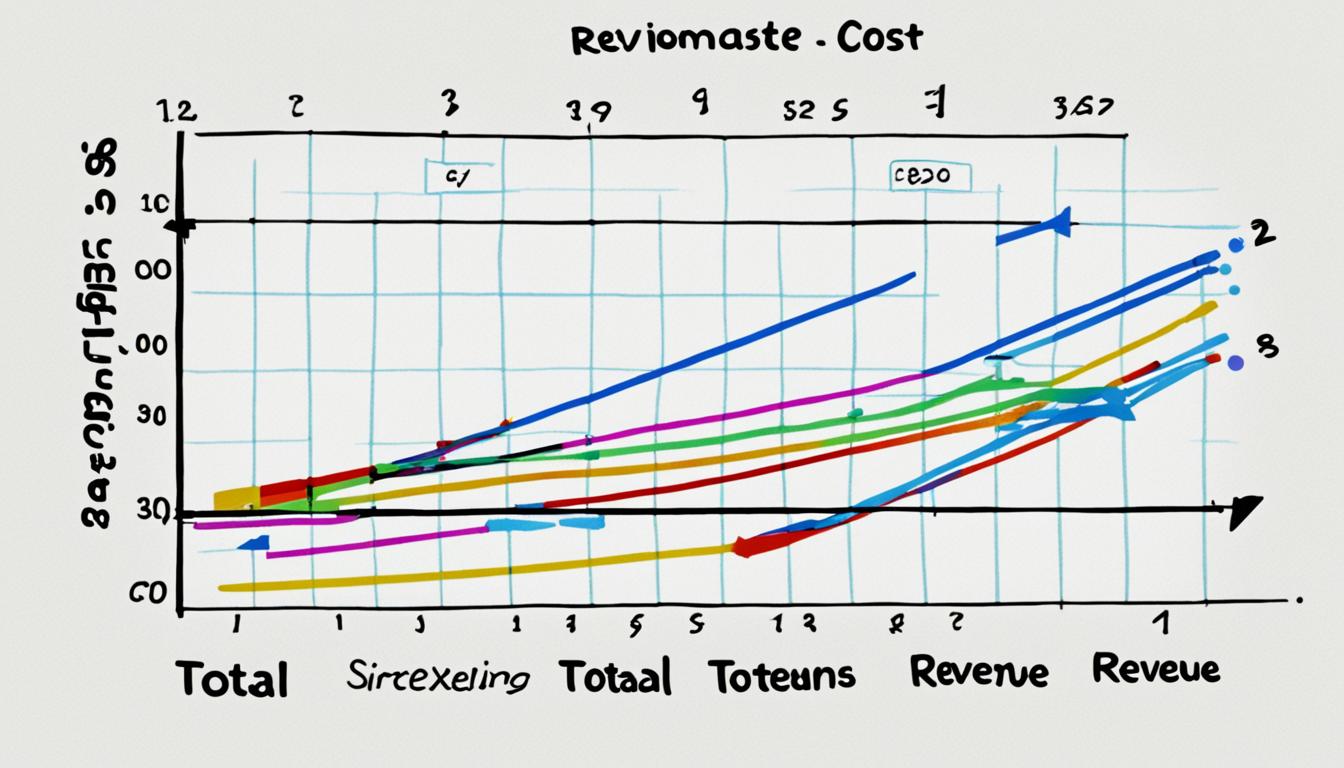The break-even point is a crucial concept in business that helps determine when a company or product will start to be profitable. It is calculated by dividing fixed costs by the contribution margin, which is the selling price per unit minus the variable costs per unit. Understanding how to work out the break-even point is essential for setting prices, forecasting profitability, and making informed business decisions.
Calculating the break-even point involves analyzing the relationship between costs, revenue, and profit. By determining the level of production or sales revenue required to cover costs, businesses can work towards achieving profitability and sustaining their operations. This analysis is known as break-even analysis.
Break-even analysis involves evaluating multiple factors such as fixed costs, variable costs, break-even revenue, break-even sales volume, and the break-even formula. It helps businesses understand how changes in costs and sales affect their profitability and guides them in making strategic decisions.
Next, we will explore what the break-even point is and how to work out break even point providing examples and discussing the limitations and benefits of this essential financial analysis tool. Let’s dive in!
What is the Break-Even Point?
The break-even point is the level of production at which a company’s total revenue equals its total costs. It signifies the equilibrium where a business neither makes a profit nor incurs a loss. Calculating the break-even point enables businesses to determine the minimum revenue required to cover costs and achieve profitability. This metric plays a crucial role in assessing a business’s financial health and making strategic decisions.
To better understand the concept of the break-even point, imagine a scenario where a company’s revenue just covers its costs. In this situation, the business is said to have reached the break-even point. Beyond this point, any additional revenue generated translates into profit. Conversely, below the break-even point, the business incurs losses.
Let’s take a closer look at the components involved in calculating the break-even point:
- Revenue: This refers to the total income generated by a business through the sale of its products or services.
- Costs: These encompass all expenses incurred by a business, including both fixed costs and variable costs.
- Profitability: It is the measure of a business’s ability to generate profits and is directly influenced by the break-even point.
Calculating the break-even point allows businesses to gain a clearer understanding of their financial position. This knowledge empowers them to set realistic revenue targets and establish prices that adequately cover costs, ensuring profitability. By conducting a break-even analysis, businesses can make informed decisions to optimize their operations and drive sustainable growth.
“The break-even point is a fundamental concept that helps businesses determine their revenue goals and assess their financial viability.” – Financial Expert
Break-Even Point Calculation Example:
To illustrate the break-even point calculation, let’s consider a hypothetical scenario:
| Fixed Costs | Variable Costs Per Unit | Selling Price Per Unit |
|---|---|---|
| £10,000 | £5 | £15 |
In this example, the fixed costs are £10,000, the variable costs per unit are £5, and the selling price per unit is £15. Using the formula, the break-even point can be calculated based on the contribution margin:
Break-even Point = Fixed Costs / (Selling Price per Unit – Variable Costs per Unit)
By substituting the values from the example into the formula:
| Break-Even Point |
|---|
| £10,000 / (£15 – £5) = £10,000 / £10 = £1,000 |
The break-even point, in this case, is £1,000. Therefore, the business needs to generate a minimum of £1,000 in revenue to cover its costs and achieve profitability.

In the next section, we will explore the methods used to calculate the break-even point in more detail, discussing both the units sold and sales revenue-based approaches.
How to Work Out Break Even Point in Business?
There are two primary methods for calculating the break-even point. The first method is based on the number of units sold, where the fixed costs are divided by the revenue per unit minus the variable costs per unit. The second method is based on sales in GBP, where the fixed costs are divided by the contribution margin.
The contribution margin is calculated as the selling price per unit minus the variable costs per unit. Both methods provide businesses with insights into the number of units or sales revenue needed to cover their costs and reach the break-even point.
| Calculation Method | Formula |
|---|---|
| Number of Units Method | Fixed Costs ÷ (Revenue per unit – Variable Costs per unit) |
| Sales in GBP Method | Fixed Costs ÷ Contribution Margin |
Both methods provide valuable insights for businesses to understand the level of production or sales revenue required to cover their costs and achieve the break-even point. By analyzing these calculations, businesses can make informed decisions about pricing, production volume, and overall profitability.

Example Calculation:
Let’s consider a fictional clothing manufacturer with fixed costs of £10,000, a selling price per unit of £50, and variable costs per unit of £30. Using the number of units method, the break-even point can be calculated as:
Fixed Costs (£10,000) ÷ (Revenue per unit (£50) – Variable Costs per unit (£30)) = 500 units
This means that the business needs to sell 500 units of clothing to cover its costs and reach the break-even point.
Alternatively, using the sales in GBP method, the break-even point can be calculated as:
Fixed Costs (£10,000) ÷ Contribution Margin (£50 – £30 = £20) = £500
This means that the business needs to generate £500 in sales revenue in order to cover its costs and reach the break-even point.
These calculations provide businesses with valuable insights into their financial position and help them make informed decisions about pricing, production volumes, and overall profitability.
Examples of Break-Even Point Calculation
Calculating the break-even point is crucial for businesses to understand their profitability and make informed decisions. Here are a few examples that illustrate how to calculate the break-even point using different formulas and variables.
Example 1: Soft Drink Manufacturer
A soft drink manufacturer has fixed costs of £2,000, variable costs of £0.40 per can, and a sales price of £1.50 per can. Let’s calculate their break-even point.
The break-even point can be calculated using the formula:
Break-Even Point = Fixed Costs ÷ (Sales price per unit – Variable costs per unit)
Substituting the values, we have:
Break-Even Point = £2,000 ÷ (£1.50 – £0.40) = 1,818 units
Therefore, the soft drink manufacturer needs to sell 1,818 units to cover their costs and reach the break-even point.
Example 2: Clothing Retailer
A clothing retailer has fixed costs of £10,000, variable costs of £15 per unit, and a sales price of £50 per unit. Let’s calculate their break-even point.
The break-even point can also be calculated using the formula:
Break-Even Point = Fixed Costs ÷ Contribution Margin
The contribution margin is calculated as the sales price per unit minus the variable costs per unit:
Contribution Margin = £50 – £15 = £35
Now, substituting the values into the formula, we get:
Break-Even Point = £10,000 ÷ £35 = £2,727
Therefore, the clothing retailer needs to generate £2,727 in sales revenue to cover their costs and reach the break-even point.
| Example | Fixed Costs | Variable Costs per Unit | Sales Price per Unit | Break-Even Point |
|---|---|---|---|---|
| Soft Drink Manufacturer | £2,000 | £0.40 | £1.50 | 1,818 units |
| Clothing Retailer | £10,000 | £15 | £50 | £2,727 |
These examples demonstrate how businesses can utilize break-even point calculations to assess profitability and make sound financial decisions. By understanding the break-even point, companies can set realistic goals, determine pricing strategies, and evaluate their financial performance.
Limitations of the Break-Even Point
While the break-even point is a useful tool for businesses, it is important to acknowledge its limitations. The break-even point assumes that a business will sell all its stock at the same price and that variable costs will remain constant. This may not always reflect the reality of a business environment where costs fluctuate and product prices may vary. Additionally, inaccurate calculations or unrealistic assumptions about the number of products sold can lead to inaccuracies in the analysis. It is important for businesses to consider these limitations and use the break-even point as a guide rather than an absolute measure of profitability.
Benefits of a Break-Even Analysis
Conducting a break-even analysis offers several benefits for businesses. It can help uncover missing expenses, limit decisions based on emotions, establish goals, secure funding, and set appropriate prices. By providing a clear understanding of the financial aspects of a business, a break-even analysis enables businesses to make informed decisions, set achievable goals, and communicate their financial plans to investors or lenders. It also assists in pricing products accurately to ensure profitability and sustainability.
Setting business goals and making strategic decisions are important for long-term success. A break-even analysis provides valuable insights into the financial viability of different options, allowing businesses to assess their profitability and make informed choices. By understanding the break-even point, businesses can determine the level of sales, production, or revenue required to cover costs and achieve profitability. This knowledge helps business owners and managers to set realistic goals and make data-driven decisions that align with the financial health of the company.
An accurate break-even analysis also enhances a business’s ability to secure funding. When seeking investment or loans, it is crucial to demonstrate a clear understanding of the financial aspects of the business and its potential for profitability. By presenting a break-even analysis, businesses can showcase their financial stability and provide concrete evidence of their ability to generate revenue and cover costs. This increases their chances of obtaining funding from investors or financial institutions.
Pricing strategies play a critical role in determining the success of a product or service. By using break-even analysis, businesses can establish appropriate prices that will cover their costs and generate a profit. The analysis helps identify the breakeven revenue that needs to be achieved to cover all expenses, ensuring that prices are set at a level that guarantees profitability. It also assists in understanding the impact of different variables, such as changes in costs or sales volume, on pricing decisions. With this information, businesses can adapt their pricing strategies to remain competitive and achieve their financial goals.
Overall, a break-even analysis is an essential tool for businesses in making informed decisions, setting realistic goals, securing funding, and establishing effective pricing strategies. It provides a comprehensive understanding of the financial aspects of a business, enabling owners and managers to navigate the complexities of the market and ensure long-term profitability and success.

Conclusion
Understanding and calculating the break-even point is crucial for businesses looking to assess their financial health and make informed decisions. By determining the level of production or sales revenue needed to cover costs, businesses can work towards achieving profitability and sustaining their operations.
The break-even point serves as a valuable metric for evaluating a business’s success and viability. It allows owners and managers to gauge the minimum level of revenue required to cover expenses and start generating profits. This knowledge is essential for setting prices, forecasting profitability, and making strategic business decisions.
Financial analysis, including the calculation of the break-even point, provides businesses with a comprehensive understanding of their revenue streams, costs, and overall profitability. By conducting a thorough analysis, businesses can identify areas for improvement, optimize their operations, and set achievable financial goals. Whether it’s securing funding, setting prices, or planning for future growth, a solid understanding of the break-even point and financial analysis is key to business success.




